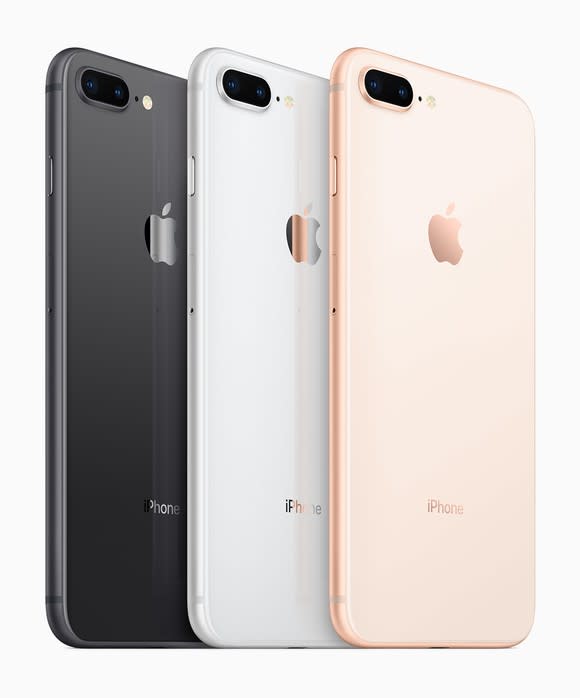2 Big Upgrades to Expect in Apple Inc.’s 2018 iPhones
Although Apple's (NASDAQ: AAPL) latest smartphones -- the iPhone 8, iPhone 8 Plus, and iPhone X -- seem to be doing well in the marketplace, next year's lineup should be even more competitive.
The 2018 iPhones will almost certainly sport substantial capability improvements across the board, and in this column, I'd like to go over two of the more interesting -- and related -- ones.

Image source: Apple.
Faster, more efficient cellular technology
This year's iPhones support download speeds over cellular networks of up to 600 megabits per second and upload speeds over cellular of up to 150 megabits per second.
For most users, those speeds should be good enough, but there's no denying that Apple is a step behind other flagship smartphone vendors, which currently offer devices with peak theoretical cellular speeds of 1 gigabit per second downloading (that's 1,000 megabits) and 150 megabits per second uploading
This limits Apple's ability to tout the wireless capabilities of its phones, as it would make it easier for competitors to use that disparity against Apple in their own marketing.
Next year, per generally reliable KGI Securities analyst Ming-Chi Kuo, Apple will use upgraded cellular modems from both Intel (NASDAQ: INTC) and Qualcomm (NASDAQ: QCOM), respectively -- as well as new antenna designs -- to enable gigabit LTE speeds.
It's not just peak theoretical speeds that will improve with these new modems; they should also be far more power efficient, which could potentially translate into better battery life, particularly in cellular-heavy use cases.
The Qualcomm X16 modem inside of the Qualcomm-based iPhones is built using Samsung's (NASDAQOTH: SSNLF) 14nm LPP manufacturing technology, and the Intel XMM 7480 modem inside of the Intel-based iPhones is built using an unspecified chip manufacturer's older 28nm manufacturing technology.
The Intel-based iPhones next year are expected to use Intel's XMM 7560 LTE modem, which is manufactured using the company's in-house 14nm technology. This manufacturing technology migration should mean substantially better modem chip efficiency and, ultimately, battery life for the Intel-based iPhones.

Image source: Apple.
The Qualcomm-based iPhones are also expected to get manufacturing technology-related power efficiency improvements next year, too. The Snapdragon X20 LTE modem that's expected to go into the next generation of Qualcomm-based iPhones is expected to be manufactured using Samsung's 10nm LPE technology, which is more efficient than the prior generation 14nm LPP technology.
The efficiency gap between Samsung's 14nm LPP and Samsung's 10nm LPE isn't anywhere near as wide as the one between the foundry 28nm technology and the Intel 14nm technology, but it'll still be an improvement.
If Apple markets this upgrade to consumers correctly, blazing fast cellular speeds and potentially better battery life thanks to more efficient modems could be interesting selling points for the 2018 iPhones.
Better Wi-Fi
It's not just cellular speeds that are likely to get a boost in next year's iPhones; Apple is likely to use a new Wi-Fi/Bluetooth combination chip from longtime supplier Broadcom (NASDAQ: AVGO) to give them a significant capability upgrade.
This year's iPhones, per TechInsights, are using a chip known as the BCM4361, which is already a leading-edge mobile Wi-Fi/Bluetooth combination chipset that ticks all the right boxes: 802.11ac with 2x2 MIMO support (this helps to boost Wi-Fi performance) as well as Bluetooth 5.0 capability.
Apple hasn't much touted the Wi-Fi capabilities of its iPhones in recent product cycles, but judging from the company's aggressiveness in adopting the latest technology, the quality on that front is something that the company cares about.
I believe that next year's iPhones will use Broadcom's recently announced BCM4375 connectivity combination chip. The main upgrade that this chip delivers is support for the newer 802.11ax Wi-Fi standard, which should mean even faster transfer speeds. (For those interested in such things, this article offers more 802.11ax technical details.)
New tech is nice, but Apple must sell it
While the annual cadence of iPhone specification improvements is certainly welcome, the fact is, Apple can't just rely on more advanced technologies to sell them -- it needs to properly market the improvements to help customers understand why they should pay more to get the latest models. That's why I suspect Apple will spend a lot more time during its 2018 iPhone launch keynote talking about the generational improvements in wireless capabilities that the next iPhones will offer compared to their 2017 and perhaps even 2016 counterparts.
More From The Motley Fool
6 Years Later, 6 Charts That Show How Far Apple, Inc. Has Come Since Steve Jobs' Passing
Why You're Smart to Buy Shopify Inc. (US) -- Despite Citron's Report
Ashraf Eassa owns shares of Intel and Qualcomm. The Motley Fool owns shares of and recommends Apple. The Motley Fool owns shares of Qualcomm and has the following options: long January 2020 $150 calls on Apple and short January 2020 $155 calls on Apple. The Motley Fool recommends Broadcom Ltd and Intel. The Motley Fool has a disclosure policy.
